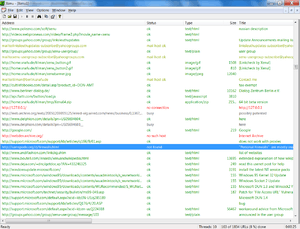Xenu's Link Sleuth
Xenu, or Xenu's Link Sleuth, is a computer program that checks websites for broken hyperlinks.[1] It is written by Tilman Hausherr and is proprietary software available at no charge. The program is named after Xenu, the Galactic Ruler from Scientology scripture.
 Screenshot of Xenu's Link Sleuth | |
| Developer(s) | Tilman Hausherr |
|---|---|
| Stable release | 1.3.8
/ September 4, 2010 |
| Written in | C++ |
| Operating system | Microsoft Windows |
| Available in | English |
| Website | home |
Format
Link Sleuth runs on Microsoft Windows. Link verification is performed on links which appear in <a> tags, as well as images, frames, plug-ins, backgrounds, local image maps, style sheets, scripts and Java applets. The program follows links to other pages, and checks the links on those pages also, so it is possible to check an entire site for broken links in one session. Xenu displays a continuously updated list of URLs which can be sorted according to different criteria.[2] The program uses a "simple, no-frills user-interface",[3] and can help users understand how certain Web sites are structured.[4] The program has support for SSL Web sites.[5]
Reception
Xenu's Link Sleuth software was called the "fastest link-checking software" by PC Magazine,[6] and "amazingly fast, very accurate" by a University of Wyoming newsletter.[7] The software was used as a testing tool in a usability study at Grand Valley State University.[8]
Xenu's Link Sleuth has also been cited by Rossett's The ASTD E-Learning Handbook,[9] Zhong's Intelligent Technologies for Information Analysis,[10] Gerrard's Risk-Based E-Business Testing,[11] Reynolds' The Complete E-Commerce Book,[12] Slocombe's Max Hits: Websites that Work,[13] George's The ABC of SEO,[14] as well as the German books Homepage-Erfolg,[15] and Einführung in XHTML CSS und Webdesign,[16] and Italian books, Plasmare il web,[17] and Il check-up dei siti Web.[18]
References
- "Looking for link validator.", New Straits Times, May 1, 2000.
- Gunther, D., Recommendation on Quality Assurance and Selection of resources for the ETB network Archived September 27, 2007, at the Wayback Machine, European Treasury Browser, P. 48., 2002, retrieved 3/7/07.
- McCoy, Linda., Link Sleuth, Deccan Herald, August 24, 2005, Retrieved 23 May 2014
- Mruck, Katja., Qualitative Research Networking: FQS as an Example, Qualitative Social Research, Volume 1, No. 3, December 2000.
- Mickiewicz, Matt., Download of the Week, SitePoint Tribune, Issue 279., SitePoint, February 5, 2004.
- "70 assists for a winning site. (Web Builder's Toolkit)", PC Magazine, April 23, 2002.
- Visual Communications eNews, University of Wyoming, June 2005., retrieved 3/7/07.
- Grissom, Scott., The Trials and Tribulations of Usability Testing, Grand Valley State University, October 8, 2003.
- Rossett, Allison (2002). The ASTD E-Learning Handbook. McGraw-Hill Professional. p. 500. ISBN 0-07-138796-X.
- Zhong, Ning; Jiming Liu (2004). Intelligent Technologies for Information Analysis. Springer. p. 200. ISBN 3-540-40677-8.
- Gerrard, Paul (2002). Risk-Based E-Business Testing. Artech House. p. 155. ISBN 1-58053-314-0.
- Reynolds, Janice (2004). The Complete E-Commerce Book: Design, Build, and Maintain a Successful Web-Based Business. CMP Books. p. 189. ISBN 1-57820-312-0.
- Slocombe, Mike (2002). Max Hits: Websites that Work. Rotovision. p. 121. ISBN 2-88046-543-5.
- George, David (2005). The ABC of Seo: search engine optimization strategies. ISBN 1-4116-2251-0.
- Rüttinger, Stefan (2003). Homepage-Erfolg: Wie Sie im Internet mehr Geld verdienen (in German). Books on Demand. p. 140. ISBN 3-8330-0643-9.
- Jendryschik, Michael. Einführung in XHTML CSS und Webdesign (in German). Pearson Education Deutschland. p. 250. ISBN 3-8273-2477-7.
- Polillo, Roberto (2006). Plasmare il web (in Italian). Apogeo Editore. p. 186. ISBN 88-503-2511-8.
- Polillo, Roberto (2004). Il check-up dei siti Web (in Italian). Apogeo Editore. p. 170. ISBN 88-503-2282-8.